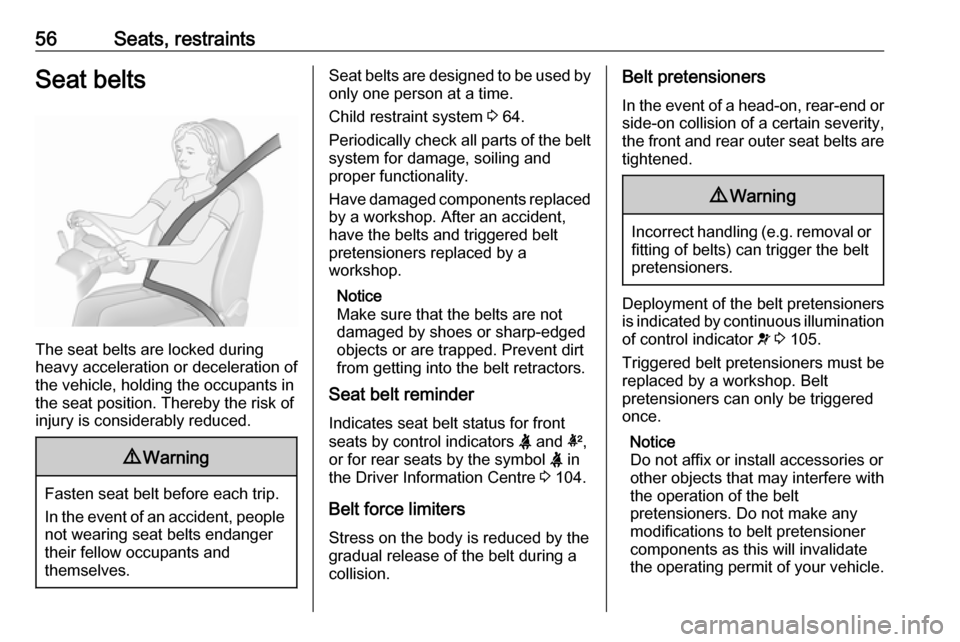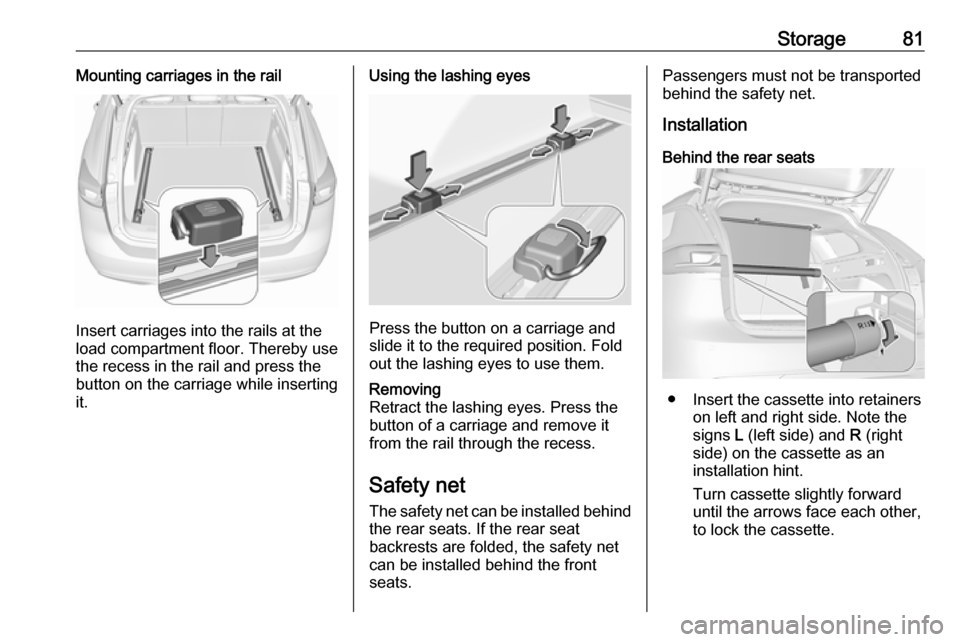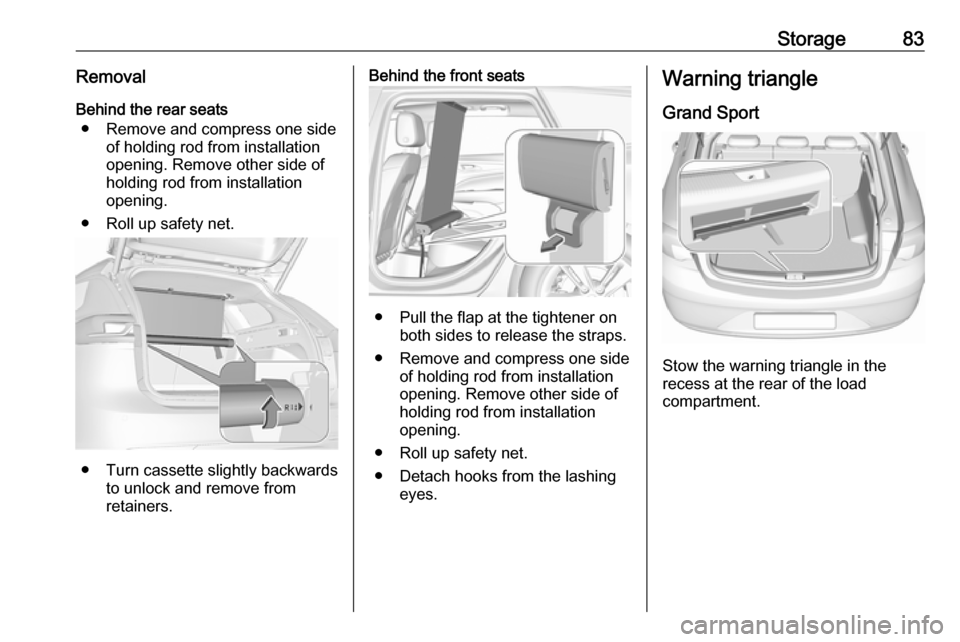lock VAUXHALL INSIGNIA 2020 Owner's Guide
[x] Cancel search | Manufacturer: VAUXHALL, Model Year: 2020, Model line: INSIGNIA, Model: VAUXHALL INSIGNIA 2020Pages: 313, PDF Size: 9.32 MB
Page 40 of 313

38Keys, doors and windowsThen swivel the control to adjust the
mirror.
Folding mirrors
For pedestrian safety, the exterior
mirrors will swing out of their normal
mounting position if they are struck
with sufficient force. Reposition the mirror by applying slight pressure tothe mirror housing.
Electric folding
Push n. Both exterior mirrors will
fold.
Push n again to return both exterior
mirrors to their original position.
If an electrically folded mirror is
manually extended, pushing n will
only electrically extend the other mirror.
Folding mirrors with remote
control or electronic key
Press e again after locking for
1 second to fold in mirrors.
Press c again after unlocking for
1 second to fold out mirrors.
This function can be activated or
deactivated in the Vehicle
personalisation.
Vehicle personalisation 3 122.
The settings are automatically stored
for the key being used 3 25.
Page 50 of 313

48Seats, restraints● Sit with shoulders as far backagainst the backrest as possible.
Set the backrest rake so that it is possible to easily reach the
steering wheel with arms slightly
bent. Maintain contact between
shoulders and the backrest when turning the steering wheel. Do
not angle the backrest too far
back. We recommend a
maximum rake of approx. 25°.
● Adjust seat and steering wheel in
a way that the wrist rests on top
of the steering wheel while the
arm is fully extended and
shoulders on the backrest.
● Adjust the steering wheel 3 88.
● Adjust the head restraint 3 45.
● Adjust the thigh support so that there is a space approx. two
fingers wide between the edge of the seat and the hollow of the
knee.
● Adjust the lumbar support so that
it supports the natural shape ofthe spine.Manual seat adjustment
Drive only with engaged seats and
backrests.
Longitudinal adjustment
Pull handle, slide seat, release
handle. Try to move the seat back and forth to ensure that the seat is locked
in place.
Backrest inclination
Turn handwheel. Do not lean on
backrest when adjusting.
Page 58 of 313

56Seats, restraintsSeat belts
The seat belts are locked during
heavy acceleration or deceleration of
the vehicle, holding the occupants in
the seat position. Thereby the risk of
injury is considerably reduced.
9 Warning
Fasten seat belt before each trip.
In the event of an accident, people
not wearing seat belts endanger their fellow occupants and
themselves.
Seat belts are designed to be used by only one person at a time.
Child restraint system 3 64.
Periodically check all parts of the belt
system for damage, soiling and
proper functionality.
Have damaged components replaced by a workshop. After an accident,
have the belts and triggered belt
pretensioners replaced by a
workshop.
Notice
Make sure that the belts are not
damaged by shoes or sharp-edged objects or are trapped. Prevent dirt
from getting into the belt retractors.
Seat belt reminder
Indicates seat belt status for front
seats by control indicators X and k,
or for rear seats by the symbol X in
the Driver Information Centre 3 104.
Belt force limiters
Stress on the body is reduced by the
gradual release of the belt during a
collision.Belt pretensioners
In the event of a head-on, rear-end or side-on collision of a certain severity,
the front and rear outer seat belts are
tightened.9 Warning
Incorrect handling (e.g. removal or
fitting of belts) can trigger the belt
pretensioners.
Deployment of the belt pretensioners
is indicated by continuous illumination
of control indicator v 3 105.
Triggered belt pretensioners must be replaced by a workshop. Belt
pretensioners can only be triggered
once.
Notice
Do not affix or install accessories or
other objects that may interfere with
the operation of the belt
pretensioners. Do not make any
modifications to belt pretensioner
components as this will invalidate
the operating permit of your vehicle.
Page 73 of 313

Seats, restraints71Pedestrian protection
system
Active bonnet
Pedestrian protection system can help to reduce the injury of
pedestrians in case of a front
collision.
When the sensors in the front bumper
detect a certain impact within the
speed range of 15 mph to 31 mph, the
rear part of the bonnet will be lifted to
reduce pedestrians head injuries.
In addition the front bumper is
designed to reduce leg injuries of
pedestrians.
The active bonnet can be triggered
only once and remains in the raised
position. A message is displayed in
the Driver Information Centre.
Seek the assistance of a workshop as soon as possible, thereby adapting
the driving style, to have the
actuators, hinges and bonnet
replaced.9 Warning
Do not drive with the bonnet
raised.
9 Warning
After any frontal accident the front
bumper may appear to be intact,
however, the sensors may be
damaged. Consult a workshop to
verify proper functionality of the
sensors.
The system may not trigger under the following conditions:
● The impact is out of sensor range.
● The sensors are damaged or blocked by accessory parts.
● The bonnet is blocked by snow or
ice.
● The vehicle speed is not within the range.
● The object is too small.
Manually bonnet lowering9 Warning
After the system has triggered, the
hinges of the bonnet are hot. Do
not touch.
To manually lower the triggered
bonnet for driving to the next
workshop:
1. Pull the bonnet release lever.
2. Push the safety catch to left vehicle side.
3. Open the bonnet approx. 20 cm and lower it slowly without
engaging.
4. Push down bonnet with both hands at rear corners in small
steps alternating between right
and left side.
9 Warning
Be sure to keep away from the
edge of the bonnet to prevent
injuries.
Page 78 of 313

76Storage
The backrests are properly
engaged when the red mark near the release levers are no longer
visible.
9 Warning
When folding up, ensure that
backrests are securely locked in
position before driving. Failure to
do so may result in personal injury or damage to the load or vehicle in the event of hard braking or a
collision.
The seat belt of the centre seat could
be blocked when the backrest is
folded up too quickly. To unlock the
retractor, push in the seat belt or pull
it out by approx. 20 mm then release.
Load compartment extension
(three-part rear seat backrest)
● Fold up the rear armrest.● Pull the loop and fold down the backrest of the centre seat.
Page 79 of 313

Storage77● Pull the release lever on one orboth outer sides and fold down
the backrests onto the seat
cushion.9 Warning
Take care when folding down the
right outer seat backrest if the
centre seat backrest is already
folded down. Risk of injury due to bolt protruding from the inner side
of the backrest.
● Alternatively fold seat backrests from the load compartment: pullswitch on left or right sidewall of
the load compartment to fold the
corresponding part of the rear
seat backrest.9 Warning
Take care when operating the rear
backrests from the load
compartment. The backrest is
folded with considerable force.
Risk of injury, particularly to
children.
Ensure that nothing is attached to
the rear seats or located on the
seat cushion.
● To fold up, raise the backrests and guide them into an upright
position until they engage
audibly. Make sure that the belts
are positioned correctly and stay
clear of the folding area.
The backrests are properly
engaged when the red mark on
the release levers on both sides
are no longer visible.
9 Warning
When folding up, ensure that
backrests are securely locked in
position before driving. Failure to
do so may result in personal injury or damage to the load or vehicle in the event of hard braking or a
collision.
Page 80 of 313

78Storage
The seat belt of the centre seat couldbe blocked when the backrest is
folded up too quickly. To unlock the
retractor, push in the seat belt or pull
it out by approx. 20 mm then release.
Rear storage
Storage box
A storage box is located in the load
compartment. Remove the cover to
gain access to the storage box.
Rear floor storage cover 3 80.
Load compartment cover Do not place any objects on the cover.
Grand Sport
Removing cover
Unhook retaining straps from tailgate.
Page 83 of 313

Storage81Mounting carriages in the rail
Insert carriages into the rails at the
load compartment floor. Thereby use
the recess in the rail and press the
button on the carriage while inserting
it.
Using the lashing eyes
Press the button on a carriage and
slide it to the required position. Fold out the lashing eyes to use them.
Removing
Retract the lashing eyes. Press the
button of a carriage and remove it
from the rail through the recess.
Safety net
The safety net can be installed behind the rear seats. If the rear seat
backrests are folded, the safety net
can be installed behind the front
seats.
Passengers must not be transported
behind the safety net.
Installation
Behind the rear seats
● Insert the cassette into retainers on left and right side. Note the
signs L (left side) and R (right
side) on the cassette as an
installation hint.
Turn cassette slightly forward until the arrows face each other,
to lock the cassette.
Page 85 of 313

Storage83RemovalBehind the rear seats ● Remove and compress one side of holding rod from installation
opening. Remove other side of
holding rod from installation
opening.
● Roll up safety net.
● Turn cassette slightly backwards to unlock and remove from
retainers.
Behind the front seats
● Pull the flap at the tightener on both sides to release the straps.
● Remove and compress one side of holding rod from installation
opening. Remove other side of
holding rod from installation
opening.
● Roll up safety net.
● Detach hooks from the lashing eyes.
Warning triangle
Grand Sport
Stow the warning triangle in the
recess at the rear of the load
compartment.
Page 89 of 313

Instruments and controls87Instruments and
controlsControls ....................................... 88
Steering wheel adjustment ........88
Steering wheel controls .............88
Heated steering wheel ...............88
Horn ........................................... 89
Windscreen wiper and washer ..89
Rear window wiper and washer ...................................... 91
Outside temperature ..................92
Clock ......................................... 92
Power outlets ............................. 93
Inductive charging .....................94
Ashtrays .................................... 95
Warning lights, gauges and indi‐ cators ........................................... 96
Instrument cluster ......................96
Speedometer ........................... 100
Odometer ................................ 101
Trip odometer .......................... 101
Tachometer ............................. 102
Fuel gauge .............................. 102
Engine coolant temperature gauge ..................................... 102
Service display ........................ 103Control indicators ....................104
Turn lights ................................ 104
Seat belt reminder ...................104
Airbag and belt tensioners .......105
Airbag deactivation ..................105
Charging system .....................105
Malfunction indicator light ........105
Brake and clutch system .........106
Electric parking brake ..............106
Electric parking brake fault ......106
Antilock brake system (ABS) ...106
Gear shifting ............................ 107
Following distance ...................107
Lane keep assist .....................107
Electronic Stability Control off . 107
Electronic Stability Control and Traction Control system .........107
Traction Control system off .....107
Engine coolant temperature ....107
Preheating ............................... 108
AdBlue ..................................... 108
Tyre pressure monitoring system .................................... 108
Engine oil pressure ..................108
Low fuel ................................... 108
Immobiliser .............................. 109
Exterior light ............................ 109
High beam ............................... 109
High beam assist .....................109
LED headlights ........................ 109Front fog lights......................... 109
Rear fog light ........................... 109
Cruise control .......................... 109
Adaptive cruise control ............109
Vehicle detected ahead ...........110
Pedestrian detection ................110
Speed limiter ........................... 110
Traffic sign assistant ................110
Door open ................................ 110
Displays ..................................... 110
Driver Information Centre ........110
Info Display .............................. 116
Head-up display ......................117
Vehicle messages ......................121
Warning chimes .......................121
Vehicle personalisation ..............122
Telematics service .....................126
Emergency call ........................126